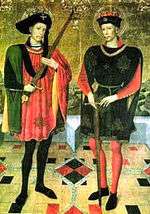Abdon and Sennen
Saints Abdon and Sennen, variously written in early calendars and martyrologies Abdo, Abdus, and Sennes, Sennis, Zennen, are recognized by the Roman Catholic Church as Christian Martyrs, with a feast day on 30 July.[2] In some places they have been honoured on 20 March, and the first Sunday of May.[3]
Saints Abdon and Sennen | |
|---|---|
 Saints Abdon and Sennen | |
| Martyrs | |
| Born | 2rd century Persia (modern-day Iran) |
| Died | c. 250 Rome |
| Venerated in | Roman Catholic Church |
| Canonized | Pre-Congregation |
| Feast | 30 July |
| Attributes | Fur tunics; sword; Phrygian caps; two crowns; in a den of lions and bears[1] |
| Patronage | children;[1] invoked for good harvest;[1] burying the dead, coopers, Pescia; Sahagún, León; Calasparra |
Nothing is known historically about these saints except their names, that they were martyrs, and that they were buried on 30 July of some year in the Cemetery of Pontianus on the Via Portuensis.[2] Because of this lack of knowledge about them, they are no longer listed in the General Roman Calendar to be commemorated liturgically worldwide,[4] but they may still be celebrated everywhere on their feast day unless in some locality an obligatory celebration is assigned to that day.[5] The rank of their celebration was given as "Simple" in the Tridentine Calendar and remained such until the classification was changed to that of "Commemoration" in the General Roman Calendar of 1960.
Veneration
Their Acts, written for the most part prior to the 9th century, describe them as Persians martyred under Decius,[1][6] approximately in the year 250 A.D. Their Acts contain several fictitious statements about the cause, the circumstances of their coming to Rome and the nature of their torments. They relate that their bodies were buried by a subdeacon, Quirinus, and later transferred in the reign of Constantine to the Cemetery of Pontianus on the road to Porto, near the gates of Rome.
A fresco found on the sarcophagus supposed to contain their remains represents them receiving crowns from Christ. According to Martigny, this fresco dates from the seventh century. Several cities, notably Florence and Soissons, claim possession of their bodies, but the Bollandists say that they rest in Rome, in the Basilica of St. Mark. The Benedictine Abbey of Sainte Marie in Arles-sur-Tech, France also claims a tomb.
Abdon and Sennen are patron saints of Calasparra, in Murcia, Spain. The feasts days celebrated in their honor in this Spanish town date back to the 16th century.[7]
List of churches dedicated to these saints
- Germany
- St. Abdon & Sennen Church, Salzgitter-Ringelheim, Lower Saxony
- Spain
- Hermitage of the stone saints, Cullera, Valencian Community.[8]
- Hermitage of the stone saints, Sueca, Valencia.[9]
St. Sennen's Church in Sennen, Cornwall is in fact dedicated to St Sinninus (also known as St Senan), a sixth-century Irish bishop.[10]
See also
References
- "Saints of July 30: Abdon and Sennen". St. Patrick Catholic Church Saint of the Day. 2009. Archived from the original on October 5, 2018. Retrieved March 19, 2012.
- "Martyrologium Romanum" (Libreria Editrice Vaticana, 2001 ISBN 88-209-7210-7)
- Holweck, F. G., "A Biographical Dictionary of the Saints," St. Louis, MO: B. Herder Book Co., 1924.
- "Calendarium Romanum" (Libreria Editrice Vaticana, 1969), p. 132
- General Instruction of the Roman Missal Archived 2008-07-20 at the Wayback Machine, 355 c
- "Sts. Abdon and Sennen". Catholic Encyclopedia. Retrieved March 19, 2012.
- "Fiestas Patronales de los Santos Mártires San Abdón y San Senén". Región de Murcia. Retrieved March 19, 2012.
- "Museo Temático-Museo del Arroz" (in Spanish). Cullera Turismo. Archived from the original on 2014-03-20. Retrieved 2012-04-10.
- "Ermitas de Sueca" (in Spanish). Ermitas de la Comunidad Valenciana. Retrieved 2014-07-01.
- Norris Deck (1851). The calendar of the Anglican church.
![]()